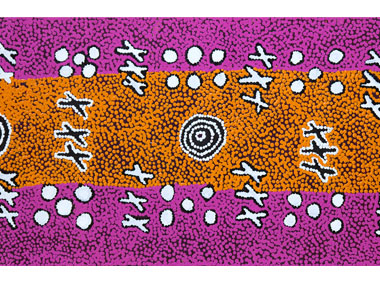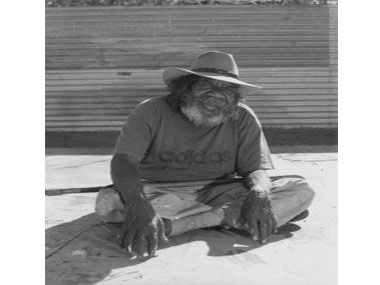Paddy Japaljarri Stewart - 30/06/35 to 30/11/13

A recent work by the late Paddy Japaljarri Stewart
Jeremy Eccles | 17.12.13
Author: Jeremy Eccles
News source: Research
Sadly, we have lost one of the real pioneers of Desert Aboriginal art, Paddy Japaljarri Stewart. Once known as Cookie Stewart, he was a chef at Papunya and was involved as a relative of Clifford Possum and Tim Leura through both his parents when the famous Honey Ant Dreaming artwork was painted on the walls of the school with the encouragement of teacher Geoffrey Bardon. But – even more significantly – he was already painting at Yuendumu in the late 60s when the elders there realised they needed to bring their ceremonial art and designs from the distant deserts into the new community if they were to pass their culture on to future generations of Warlpiri.
The first paintings in “the last great art movement of the 20th Century” (Robert Hughes) were therefore painted in 1970/71 at Yuendemu on the walls of its new Men's Museum. And they're still there. After falling into disuse later in the 1970s, the Museum is expected to open again next year – and Paddy was an enthusiastic member of the restoration committee.
Paddy was born in 1935 at Mungapunju, south of Yuendumu, and was a station worker at Mt Allen, Mt Dennison and up in the Top End as a young man. After Papunya he returned to Yuendumu – 280 kms north west of Alice Springs - in the mid-70s, where several women, encouraged by anthropologist Francoise Dussart had started painting. Following the failure of the Museum project, he and Paddy Japaljarri Sims, Larry Jungarrayi Spencer, Paddy Jupurrula Nelson and Roy Jupurrula Curtis decided they needed more public art in the community. With the encouragement of school principal Terry Davies in 1984, they painted 30 school doors with their most important Dreamings, or jukurrpas. Stewart tackled 17 of them alone and another three in combination with the other artists. In all, they incorporated more than 200 of the key sites in their Country. His Possum Dreaming from Mungapunju shows the place where the Possums had a great fight with the Native Cat. The classroom behind that door became associated with that Dreaming.
In the tribute book about the Doors published by the Aboriginal Studies Press in 1992, Paddy is quoted as saying: “We painted these Dreamings on the school doors because the children should learn about our laws. The children do not know them and they might become like white people, which we don't want to happen”. Petrol-sniffing and graffiti were already rife in Yuendumu; this daily encounter with the law was reinforcement for the Warlpiri language in which all lessons were then taught up to year 4.
While the Papunya artists tended to use muted desert ochre colours, the Yuendumu men simply took the full range of acrylics supplied to the school for art classes when tackling the Doors. Arguably, this appearance of bright colours transformed the desert art movement. And, while Papunya Tula artists have become less and less specific in their story-telling and more abstract, the artists of the Warlukurlangu Art Centre (of which Paddy would become Chairman) retained delicate detail and rich symbolism in their art centred on the mythology of landscape. And all their Dreaming stories were recorded in detail before a painting went on sale.
The Doors remained at Yuendumu, resisting erasure for twelve years despite the desert wind and sun, bureaucratic schedules for their re-painting and robust treatment from Warlpiri schoolchildren. In 1995, the entire series of Yuendumu Doors was acquired by the South Australian Museum and then restored. Twelve of the best doors were selected for a travelling exhibition that toured Australia for three years; the Yuendumu Doors have now retruned to the South Australian Museum.
In 1988 the Power Institute at Sydney University selected six Warlpiri men from Yuendumu, including Paddy, to create a ground/sand painting, 'Yarla' for the famous 'Magiciens de la Terre' exhibition in Paris, which they installed in the Halle de la Villette in May 1989. The work received international acclaim in juxtaposition with a mud wall-painting by contemporary British artist Richard Long.
Later, in 2000, Paddy, working with Northern Editions Printmaker, Basil Hall, and collaborating once again with Paddy Sims, produced 30 etchings of the Yuendumu Doors. The first printing on a single sheet of paper was exhibited with the Doors themselves in Alice Springs. The full set of etchings, launched in 2001, won the 16th National Aboriginal and Torres Strait Islander Art Award for works on paper.
The Warlukurlangu school often included collaborative paintings – partly based on the tradition that one skin group had the rights to each story, but another group needed to be on hand to make sure they got it right; kirda made the vital decision of what to paint, but kurdungurlu had to give their permission. A marvellous collaborative work, 'Bush Cabbage Dreaming at Ngarlu' – Paddy working with Alma Nungarrayi Granites and Robin Japanangka Granites – was featured in the famous New York 'Dreamings' exhibition in 1988, a show that did so much to promote Aboriginal art in America. But a consequence of collaboration was that Paddy Stewart didn't actually have his first solo exhibition, in a 43 year painting career, until 2012. And it was in Singapore, at the Red Dot Gallery!
In 2004 Stuart Macintyre wrote in a 'A Concise History of Australia' that Paddy Japaljarri Stewart recorded his testimony in his own language in 1991. "He evokes the continuity of Dreaming from Grandfather and father to son and grandson, down the generations and across the passages of time; yet the insistence on the obligation to preserve and transmit his three jukurrpas attests to the corrosive possibility of secular change. He goes on to aver that the maintenance of Dreaming has to be 'really strict', so that his family will not lose it like paper, or throw it away or give it away to other families.
"When my father was alive this is what he taught me. He taught me the traditional ways like the traditional designs in body or head of Kangaroo Dreaming (that's what we call Marlu Dreaming) and Eagle Dreaming. He taught me to sing song for the big ceremonies. People who are related to us in a close family, they have to have the same sort of jukurrpa, and to sing songs in the same way that we do, our actions like dancing and painting on our bodies or shields or things, and this is what my father taught me. My dreaming is the Kangaroo Dreaming, the Eagle Dreaming and the Budgerigar Dreaming, so I have three kinds of Dreaming in my jukurrpa and I have to hang on to it. This is what my father taught me, and this is what I have to teach my sons the same way my father taught me, and that's way it will go on from grandparent to grandsons, and follow that jukurrpa. No-one knows when it will end."
Stewart played several major community roles as well as painting: He worked at the Yuendumu School teaching young kids, both kardiya and yapa (non-Aboriginal and Aboriginal). He taught painting, jukurrpa (Dreaming), tracking (dingo, kangaroo, goanna and bush tucker), how to make wax for sand painting, dancing, making boomerangs and many other important culture traditions. Each day Paddy drove the school bus that collected the kids. He was also involved in the council and in the Night Patrol. The Night Patrol has been absolutely invaluable as a yapa policing body.
Paddy is survived by a single daughter, Queenie Nungarrayi Stewart. She resulted from Paddy's marriage to Pansy Nakamarra Stewart, who died of renal failure in 2001. “It was a definite love match”, commented Warlukurlangu art co-ordinator, Cecilia Alfonso.
Share this:
»  del.icio.us
»
del.icio.us
»  Digg it
»
Digg it
»  reddit
»
reddit
»  Google
»
Google
»  StumbleUpon
»
StumbleUpon
»  Technorati
»
Technorati
»  Facebook
Facebook
Contact Details

The late Paddy Japaljarri Stewart

'Purlka-purlka Jukurrpa' (Old Men Dreaming) by Paddy Stewart shows the range of weaponry used in a battle between the Japaljarris and the Japangardis
Further Research
Artists: Alma Nungarrayi Granites | Clifford Possum | Larry Jungarrayi Spencer | Paddy Japaljarri Sims | Paddy Japaljarri Stewart | Paddy Jupurrula Nelson | Robin Japanangka Granites | Roy Jupurrula Curtis | Tim Leura
News Tags: Cookie Stewart | Jeremy Eccles | Paddy Stewart | Warlukurlangu Art Centre | Yuendumu | Yuendumu Doors
News Archive
- 11.10.17 | RETURN OF MUNGO MAN
- 10.10.17 | TARNANTHI 2017
- 11.08.17 | Natsiaas 2017
- 08.08.17 | ABORIGINAL ART ECONOMICS
- 02.08.17 | SCHOLL'S NEXT MOVE
- 20.07.17 | APY ART DOMINATES THE WYNNE
- 17.07.17 | Anangu Artist Wins $100,000 Prize
- 14.07.17 | The End of AAMU
- 13.07.17 | YOU ARE HERE
- 11.07.17 | ART ACROSS THE COUNTRY
- 11.07.17 | TARNANTHI IN OCTOBER
- 05.07.17 | TJUNGUṈUTJA - from having come together
- 02.07.17 | BENNELONG
- 27.06.17 | JIMMY CHI
- 23.06.17 | Blak Markets at Barangaroo
Advertising

